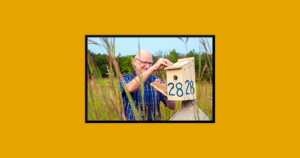Welcome back to Wisconsin to the common yellowthroat. Found throughout much of North America in breeding season, the male common yellowthroat features a distinctive “witchety-witchety-witchety” sound that even the most novice of birders might recognize.
But females might be attracted to looks. Peter Dunn, a UWM distinguished professor of biological sciences, is part of research team that authored a recent study looking at the courtship preferences of the common yellowthroats. They found that large or showy physical features of males attract females because they signal high-quality male genes, such as those linked with robust immunity or stress resistance.
On this episode of Curious Campus, we chat with Dunn about his work, the UWM Field Station and tips for aspiring birders. The hobby took flight during the height of the COVID-19 pandemic as a safe outdoor activity.
Dunn gives some background about the common yellowthroat, the importance of the study and some advice for those inspired to go see and hear these songbirds themselves. Listen to the full show at WUWM.com or on your favorite podcast app.
Describe the common yellowthroat.
Yellowthroats are about the size of chickadees. They are one of the most common warblers, and they have a big yellow throat and breast (which is also known as a bib). That’s one of their ornaments. And they also have a black mask in the male that covers the face — we sometimes call them the “Zorro bird” because of that black mask. The females are relatively nondescript — they don’t have as much yellow and it’s not as bright.
They’re very common throughout North America. They’re mostly down in Mexico in the winter. And they breed in the United States and southern Canada. They like marshy areas and they have a song that’s pretty familiar to birdwatchers.
How does your study help us better understand these songbirds?
It helps us understand why birds are so attractive-looking. It also helps us understand how evolution works in terms of understanding why some creatures have crazy-looking ornaments and traits.
Is the backyard the best place to start birding?
Sure! You can see lot of cool things in your backyard. I’ve had some really weird things in my backyard. A couple years ago, I had a Townsend’s solitaire, a bird that’s only found in Colorado and further west, and it liked the juniper berries on the tree in my backyard. I just put out a notice on the local bird-watching network over email that I had this bird in my backyard, and I had dozens of people coming to see this bird. You can see some really cool things sometimes.
But yes, bird feeders are good. The other thing to get started is to look at the Wisconsin Society for Ornithology webpage. They have a whole bunch of field trips, so I would suggest people go on some field trips and meet people who are more experienced, and can help identify things. There’s also the Audubon societies around town and the Urban Ecology Center — they all have field trips, so that would be a good way to get started.
Field trips are fun because you meet other people, and birding is a social thing, to a large extent. You get to share the excitement of seeing a new bird for the first time. … And get one of those apps from Cornell or Audubon, and a pair of binoculars. That would really help.
